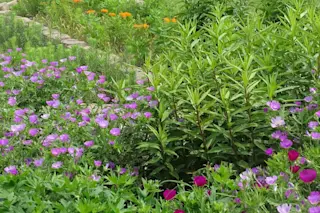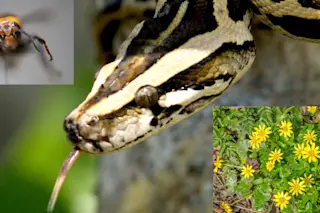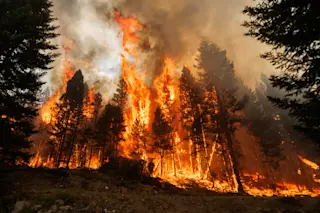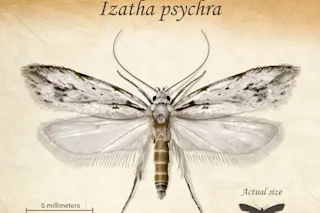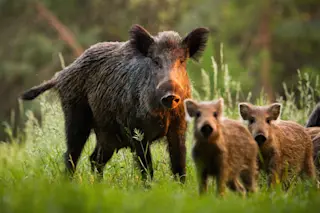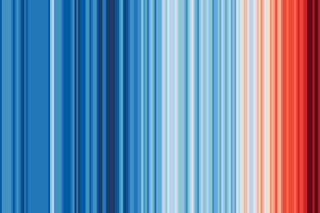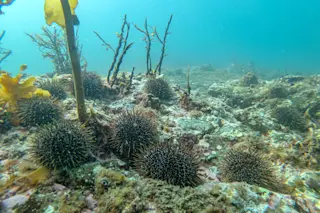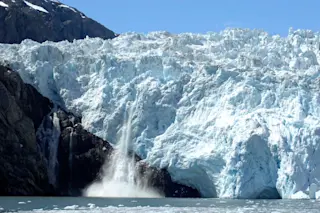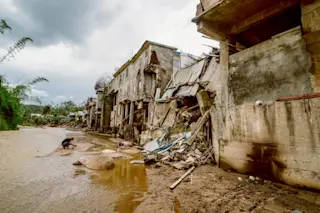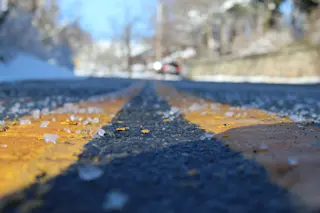Its stakes are high, says paleontologist Paul Olsen. Does carbon belong in the atmosphere or the deep ocean? Should Earth be hot or cold?
To most people the sight of antelopes grazing placidly in a meadow would epitomize the peaceful balance of nature. But Paul Olsen, a paleontologist at the Lamont-Doherty Earth Observatory in New York, has come to see things differently. To him that meadow is just the latest battlefield in the primordial struggle between plants and the animals that eat them. And that war, Olsen claims, has had global repercussions: as its front line has surged back and forth over the past 450 million years, it has dragged Earth’s climate along with it by changing the amount of carbon dioxide in the atmosphere.
Over geologic time Earth’s climate depends first and foremost on carbon dioxide, which traps heat and creates a greenhouse effect. The molecules of CO2 in the air at any moment are part of a vast cycle that involves the entire planet. Volcanoes steadily emit CO2, which dissolves in water droplets in the atmosphere to form carbonic acid and falls to the ground as rain. The carbonic acid reacts with rocks, releasing ions of bicarbonate that flow into rivers and on to the ocean--a process known as weathering. In the ocean, plankton use the bicarbonate to build shells of calcium carbonate. When they die and settle onto the seafloor, their shells turn to limestone, and the carbon returns to the solid Earth.
Plants on land can alter this cycle by speeding up weathering. They do so in two ways. As they make organic matter through photosynthesis, they take up CO2, thus providing a separate avenue by which it leaves the atmosphere. Some of the CO2 gets pumped out through the plants’ roots when they respire, and the rest is released when the plants die and are decomposed by bacteria. The CO2 reacts with water in the soil to form carbonic acid--the weathering agent. Most of the carbonic acid involved in weathering today comes from the soil rather than from rain. And the soil itself, which is also produced by decomposing plants, speeds up weathering in a second way: it acts as a sponge that traps the carbonic acid and keeps it in close contact with the rock.
Although weathering can and does take place in the absence of plants, the best guess is that plants accelerate the process by a factor of ten. For some time now many researchers have argued that the evolution of land plants must therefore have had a profound effect on climate: by removing carbon from the atmosphere and putting it in the deep ocean, plants have diminished the greenhouse effect and cooled the planet.
But five years ago, as Olsen was preparing to teach a course on dinosaurs at Columbia University, he started to wonder whether climate researchers were actually missing half the picture. Animals are completely left out of any theoretical studies of long-term climate change, he says. The assumption has been that herbivores don’t have a large-scale effect on vegetation--yet anyone who has studied a modern ecosystem, says Olsen, knows that assumption is false. Goats can turn lush islands into bare humps of dirt. Elephants eat or knock over so many trees that they can transform dense jungles into open forests.
Nor is such destructiveness a modern invention: dinosaurs were probably the greatest plant eaters that ever lived. If the success of plants has a net cooling effect on Earth’s climate, Olsen realized, the success of herbivores should have the opposite effect. The more plant eaters there are, the fewer plants there are and the more slowly rocks weather. The more slowly rocks weather, the more CO2 remains in the air. The more CO2 remains in the air, the warmer the climate becomes. It became obvious that this was a theory I couldn’t exclude, says Olsen. That’s how you go off on these roads. You want to try to exclude it and you can’t, so you have to explore it.
Olsen’s exploration has now taken him to a hypothesis encompassing not just dinosaurs but the entire history of life on land. In his view, herbivores evolve to eat plants, the plants evolve ways of eluding the herbivores, and the herbivores evolve again. As each side gets the upper hand, it changes the weathering rate, which in turn steers the planet between balmy and cold climates. The evidence for this scenario, says Olsen, is the record preserved in rocks--fossils that show the abundance of animals and plants at various epochs, isotopes that indicate how much CO2 was in the air, and formations that trace the advance and retreat of glaciers.
The war began quietly about 450 million years ago, when plants first invaded land. The first primitive lichens and mosslike species reproduced slowly, had no roots, and consequently didn’t cause much weathering. Around 400 million years ago, though, vascular plants evolved. They were able to extract water and nutrients from the ground with roots and carry them to the top of an upright trunk. That allowed them to colonize drier land.
Leaves and seeds came next, and they helped the plants’ cause even more. By 350 million years ago trees with three-foot-wide trunks forested many parts of the world. One sign of how well plants did is the vast amount of coal--plant matter that was buried and compressed in swamps- -that dates back to the Paleozoic Era. The creation of coal itself helped remove CO2 from the air, but plant-induced weathering removed five times more. And shortly after forests became widespread, a chill gripped Earth for 30 million years.
But why did plants do so well in the Paleozoic? One reason, says Olsen, is that nothing was around yet to eat them. Vertebrates first came on land about 360 million years ago, but almost without exception they were carnivores: reptiles and amphibians feeding on fish, insects, or one another. Evolving a digestive system able to handle terrestrial plants-- complete with grinding teeth, symbiotic gut bacteria, and a powerful gastrointestinal tract--is no easy thing, and it apparently took reptiles tens of millions of years to do so.
Once they did, though, the reward was huge. The first herbivores appeared 300 million years ago, and by 260 million years ago fossil remains show that ecosystems had changed over to the ecological pyramid we’re accustomed to, with a few carnivores at the top and huge numbers of plant eaters at the bottom. As the herbivores feasted on plants, the formation of coal all but stopped. Meanwhile, Olsen argues, the weathering cycle must have slowed drastically, leaving more CO2 in the atmosphere and heating up the planet. And in fact the rock record suggests that glaciers and polar ice caps were retreating just as the number of herbivores was increasing.
For the next 200 million years, Earth basked in a heat wave as plants struggled under attacks from herbivores. At first the treetops (where trees tend to keep their reproductive organs) were spared because the reptiles were stocky, four-legged grazers. But around 220 million years ago, tall dinosaurs appeared, some bipedal and others long-necked. When plants grew higher, dinosaurs grew longer necks.
The balance began to shift again when plants invented the flower. Flowering plants (known as angiosperms) boast enclosed reproductive systems and rugged seeds, which allow them to reproduce much faster than their ancestors. At first, 100 million years ago, they were small bushes living in marginal areas. By 80 million years ago they were spreading quickly through the understory of forests. New, ground-grazing dinosaurs such as Triceratops evolved to feed on them, but the angiosperms continued to explode across the landscape. At the same time, the planetary hothouse began to cool.
We’ll never know if dinosaurs could have beaten back the angiosperms. A comet, many geologists now believe, crashed into the coast of Mexico 65 million years ago, creating a global pall of dust and sulfuric acid droplets that killed off so many plants that the animals that fed on them starved. The dinosaurs and many other animals disappeared forever.
The impact itself would have caused only a few months of cooling, Olsen points out--yet the climate actually kept cooling for millions of years. If you wipe out all the herbivores, you set the clock back to zero, he explains. The fast-growing angiosperms recovered from the impact, and without any herbivorous dinosaurs left to bother them, they eventually created gigantic forests. The weathering rate sped up again, and more greenhouse gas was converted to limestone.
Mammals now had to play the same game of evolutionary catch-up as the reptiles had 300 million years earlier. It wasn’t until 10 million years after the death of the dinosaurs that the ancestors of such modern plant eaters as buffalo, horses, elephants, and rabbits appeared. Once they did, the climate went through a relatively brief warming. Tropical forests spread to higher latitudes even as the total amount of vegetation on the planet was decreasing.
In the meantime, though, the plant world had discovered its most recent and powerful weapon: grass. Grasses can spread rapidly by cloning or by means of seeds that are resistant to drought and cold, and some require less water and less light than other plants. Grass is also poor food because its leaves are loaded with bits of silica. Mammals have had to evolve new equipment for handling this rough food, such as wear-resistant teeth and multichambered stomachs. In Olsen’s view, they haven’t caught up with plants yet. When grasses became widespread 20 million years ago, Earth slid into the current cycle of ice ages.
It’s an elegant hypothesis, but is it true? Collecting the evidence to find out for sure is likely to take years. Olsen himself says, I don’t know that herbivores suppress weathering. I only see beautiful coincidences in timing in the fossil record. Other factors that affect the carbon cycle, such as bursts of mountain building (which exposes more rock to weathering) or volcanic eruptions, may turn out to have more impact on climate than the plant-herbivore war.
But if Olsen is right, the implications for the future could be profound. After all, we humans are the best plant destroyers since the dinosaurs. In a geologic twinkling we have replaced 40 percent of the planet’s wild vegetation with crops we harvest (thus preventing much of their carbon from entering the soil), pastures we graze our livestock on, and houses we build from trees we cut down. Over thousands or tens of thousands of years, says Olsen, I believe that the effects of our changes to weathering are bigger and more important than the increase in atmospheric CO2 from burning fossil fuel.



